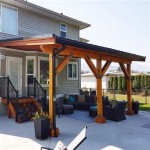Leveling Patio Pavers: Achieving Perfection with the Right Finishing Tools
Creating a visually appealing and structurally sound patio requires meticulous attention to detail. One of the most critical aspects of patio construction is ensuring a perfectly level surface. Uneven pavers not only detract from the aesthetic appeal but also create tripping hazards and can lead to premature deterioration of the patio. Achieving a flawlessly level patio requires employing appropriate leveling techniques and utilizing the right finishing tools.
The process of leveling patio pavers extends beyond simply placing the pavers on a prepared base. It involves a series of steps, each crucial to the final outcome. This includes preparing the base material, laying a bedding layer, setting the pavers, and finally, utilizing finishing tools to ensure consistent and even surfaces across the entire patio area. Neglecting any of these steps can compromise the integrity and appearance of the finished project.
The term "perfect finishing toucher tool," while perhaps not a standard industry term, encompasses the range of tools and techniques used to refine the surface of a paver patio after the initial installation. This article will explore various tools and methods that contribute to achieving a truly level and professional-looking paver patio.
Understanding the Importance of Base Preparation
Before even considering the “perfect finishing toucher tool,” one must acknowledge the crucial role of base preparation. The base is the foundation upon which the entire patio rests. A poorly prepared base will inevitably lead to uneven pavers, regardless of the finishing techniques employed. The base typically consists of compacted gravel or crushed stone, providing a stable and well-drained substrate.
The depth of the base layer depends on several factors, including the type of soil, the expected load on the patio (e.g., foot traffic versus vehicular traffic), and the local climate. In areas with significant freeze-thaw cycles, a deeper base is often necessary to prevent heaving and cracking. Proper compaction is essential to ensure the base is stable and does not settle unevenly over time. Plate compactors are commonly used to achieve thorough compaction.
After compacting the base, a bedding layer is typically added. This layer, usually composed of sand or a similar fine material, provides a smooth and level surface on which to set the pavers. The bedding layer should be evenly distributed and compacted to the correct thickness. Using screed rails and a screed board helps to create a consistently level bedding layer prior to paver placement.
Without a properly prepared and compacted base, any efforts to level the pavers with finishing tools will be largely ineffective. The instability beneath the pavers will eventually cause them to shift and settle unevenly, undoing any previous leveling work.
Key Tools for Achieving a Level Patio Surface
Several tools play a crucial role in achieving a level patio surface. These tools facilitate the accurate placement and adjustment of pavers, ensuring a consistent and even plane across the entire patio. While the term “perfect finishing toucher tool” might not be a single specific item, it represents the combined effect of using the right tools throughout the entire installation process.
Levels are indispensable for verifying the flatness and slope of the patio. A standard bubble level is useful for checking individual pavers and small areas. However, for larger patios, a laser level is recommended. Laser levels project a horizontal or vertical line, providing a visual reference for maintaining consistent elevation across the entire work area. This greatly enhances accuracy and efficiency, especially when dealing with large or complex patio designs.
Rubber mallets are essential for gently tapping pavers into place and adjusting their height. Unlike metal hammers, rubber mallets do not damage the paver surface. They allow for precise adjustments without chipping or cracking the pavers. A rubber mallet is often used in conjunction with a level to fine-tune the height of each paver until it is perfectly aligned with its neighbors.
Paver installation tools, such as paver lifters and carrying handles, can greatly simplify the process of handling and placing pavers, especially larger or heavier ones. These tools reduce strain and fatigue, allowing for more precise and efficient paver placement. They also help to minimize the risk of damaging the pavers during handling.
In addition to these tools, various other implements can assist in achieving a level patio surface. These include screed boards for leveling the bedding layer, measuring tapes and squares for accurate paver placement, and shovels and rakes for distributing and compacting the base material. The specific tools required will depend on the size and complexity of the patio project.
Finishing Touches: The Art of Fine-Tuning a Paver Patio
Even with meticulous base preparation and accurate paver placement, some minor imperfections are inevitable. This is where the “finishing touches” come into play. These final adjustments are crucial for achieving a truly level and professional-looking paver patio. This often involves a combination of techniques and careful attention to detail.
One common finishing technique is sanding. After the pavers are installed, a fine sand is swept into the joints between the pavers. This sand helps to lock the pavers in place and prevents them from shifting. The sand also fills any minor gaps between the pavers, creating a more uniform and aesthetically pleasing surface. Polymeric sand, which hardens when wetted, provides even greater stability and weed control.
Compacting the pavers after installation is another important finishing step. A plate compactor, equipped with a rubber mat to protect the paver surface, is used to vibrate the pavers and settle them firmly into the bedding layer. This process helps to eliminate any remaining air pockets beneath the pavers and ensures a consistent and level surface. Care should be taken not to over-compact the pavers, as this can damage them.
Edge restraints are crucial for preventing the pavers from shifting or spreading over time. Edge restraints are typically made of plastic, metal, or concrete and are installed around the perimeter of the patio. They provide a physical barrier that keeps the pavers in place and maintains the integrity of the patio. Proper installation of edge restraints is essential for the long-term stability and appearance of the patio.
Finally, a thorough cleaning is necessary to remove any dirt, debris, or excess sand from the paver surface. This can be done with a broom, a hose, or a pressure washer. A clean patio not only looks better but also helps to prevent the growth of mold and mildew. Regular cleaning and maintenance will help to keep the patio looking its best for years to come.
Achieving a level and aesthetically pleasing paver patio requires a combination of careful planning, meticulous execution, and the use of appropriate tools and techniques. From proper base preparation to the final finishing touches, each step is crucial to the overall success of the project. While there may not be a single “perfect finishing toucher tool,” the combined effect of using the right tools and techniques throughout the entire installation process will result in a patio that is both beautiful and durable.

Grading Tools Level For Best Hardscaping Equipment

Quick E Screeder Package Best Sand Screed Tool

Paver Leveling Gilbert Company

Pavestone 0 5 Cu Ft Paver Sand 98000

Grading Tools Level For Best Hardscaping Equipment

How To Establish Finish Grade For Pavers Diy

Grading Tools Level For Best Hardscaping Equipment

Hardscaping Levels Straight Edges Screeding Altimeters

Costway 67 In Lawn Leveling Rake Heavy Duty Level Tool For Garden Backyard Gt4043gn

Grading Tools Level For Best Hardscaping Equipment
Related Posts








